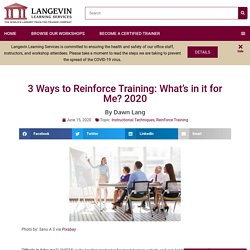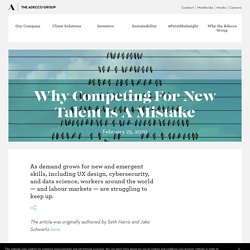

Schools and teachers. 3 Ways to Reinforce Training: What’s in it for Me? 2020. Dawn Lang Dawn has been a course leader with Langevin since 2015.

She completed a Bachelor of Science degree in Elementary Education at Kansas State University, followed by a Master’s in Information and Learning Technologies/Instructional Design from the University of Colorado Denver. Her passion for teaching started in third grade and she’s never looked back! As an educator, technology trainer, instructional designer, and facilitator of virtual training, she’s had the opportunity to work with a variety of stakeholders in all different contexts to support their learning and application of skills and knowledge. As a trainer, Dawn strives to inspire and empower people to reach their full potential. All Posts by the author. 5-Step Process for Working with Subject-Matter Experts. A more educated workforce? - VDC. This work from NCVER focuses on how the proportion of workers with vocational education and training (VET) qualifications has changed since 2006.

The workforce is now more educated, but are their skills being used well? A changing dynamic? A new report from NCVER’s Lisel O’Dwyer and Ian White is entitled “The dynamics of qualifications: implications for VET.” As the report points out: “The analysis finds that, over the last decade, the overall workforce has become more educated: the proportion of workers holding VET or higher education qualifications has increased, while the numbers and proportion of workers without post-school qualifications has correspondingly decreased.” The 4 D's of Learning: A quick illustrated guide to Modern Workplace Learning : Modern Workplace Learning 2020 [Magazine]
The following is a quick illustrated guide to what you will find in my Modern Workplace Learning 2020 (MWL2020) resource.
![The 4 D's of Learning: A quick illustrated guide to Modern Workplace Learning : Modern Workplace Learning 2020 [Magazine]](http://cdn.pearltrees.com/s/pic/th/learning-illustrated-workplace-221235910)
The 4 D’s of Learning Following the results of my 2019 Top 200 Tools for Learning (13th annual) survey I analysed the 100 tools on the Top Tools for Personal and Professional Learning list and identified 4 main uses of the tools as ways of learning which I called the 4 D’s of Learning (and which I mapped on the diagram below). Although the diagram above shows how the 4 D’s of Learning are connected to one another, it is more appropriate to think of them as overlapping ways of learning. It is then easy to identify what and how learning takes place across the organisation. Why Competing For New Talent Is A Mistake - The Adecco Group. As demand grows for new and emergent skills, including UX design, cybersecurity, and data science, workers around the world — and labour markets — are struggling to keep up.

The article was originally authored by Seth Harris and Jake Schwartz here. According to a recent survey conducted by the World Economic Forum, nearly eight in 10 global CEOs say they’re concerned about the availability of people with the right skills. So far, organizations have responded by engaging in a war for talent — that is, buying or stealing it, rather than growing it from within. As they compete to fill roles, many have been willing to spend billions on recruiting (or poaching), while reluctant to invest in training their existing workers or unskilled ones, perhaps out of fear their competitors will hire those newly attractive employees away.
Spending per employee (around $1,000 per year on average) remains just a fraction of cost-to-hire (which most estimates place around $4,000). Government spending on education: the winners and losers. When it comes to government spending, all parts of education are not treated equally, new research shows.

Over the last decade, spending on Vocational Education and Training (VET) has plummeted 4% below 2005 levels, while higher education expenditure soared by 45% in ten years. In schools, spending grew by over 23% in ten years and preschool expenditure increased 125% starting from a much lower base in 2005. While all education stages may not need the same amount of money, they should still receive equal attention when reforms are being considered. This is to make sure money is allocated where it will have the greatest impact. By global standards, Australia’s education system provides some significant causes for celebration. We have almost all four year olds enrolled in preschool.We achieve above OECD average scores on international school tests.And some of our universities and training centres are among the best in the world.
VET is missing out Universities appear to be the winner. Government spending on education: the winners and losers.